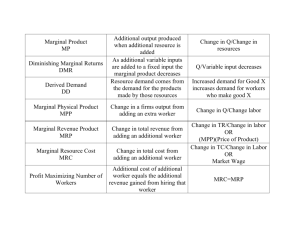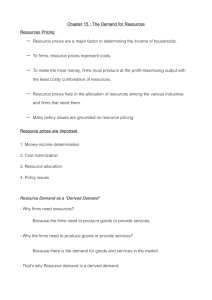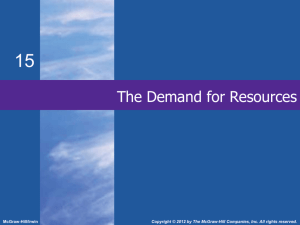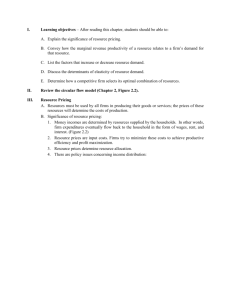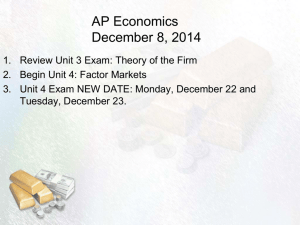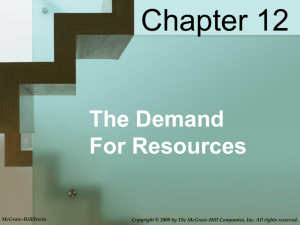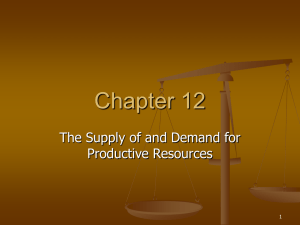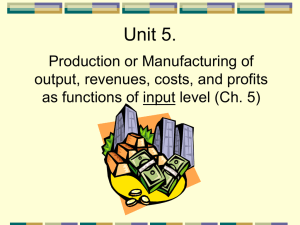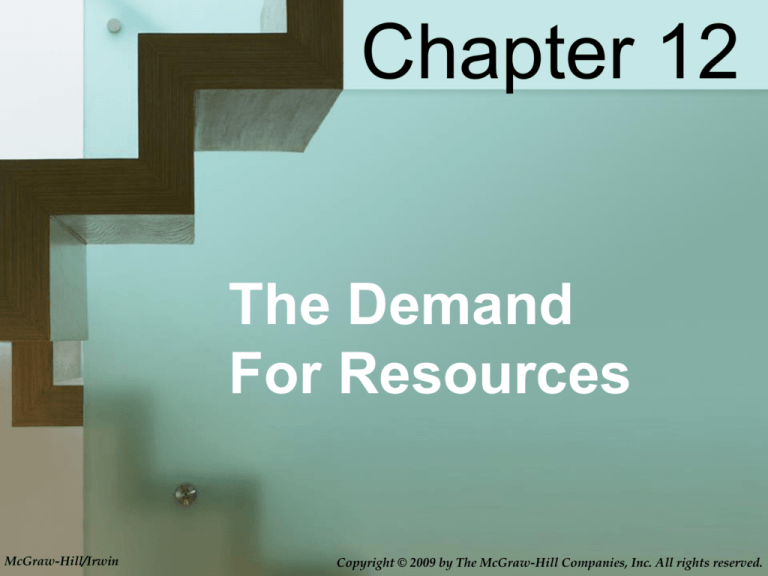
Chapter 12
The Demand
For Resources
McGraw-Hill/Irwin
Copyright © 2009 by The McGraw-Hill Companies, Inc. All rights reserved.
Chapter Objectives
• Resource pricing
• Marginal revenue productivity
and firm resource demand
• Factors that affect resource
demand
• Elasticity of resource demand
• Optimal combination of
resources for the competitive
firm
12-2
Resource Pricing
• Firms demand resources
–Focus on labor
• Resource prices are important
–Money-income determination
(households)
–Cost minimization (firms)
–Resource allocation (society)
–Policy issues (society)
12-3
Resource Demand
• All markets are competitive
(good and resource)
• Derived demand depends on:
–Productivity of resource (MP)
–Price of good it helps produce (P)
• Marginal revenue product (MRP)
–Change in TR resulting from unit
change in resource (labor)
12-4
Resource Demand
Rule for employing resources:
• MRP = MRC
• Marginal Revenue Product (MRP)
Marginal
Revenue
Product
=
Change in Total Revenue
Unit Change in Resource Quantity
• Marginal Resource Cost (MRC)
Marginal
Resource
Cost
=
Change in Total (Resource) Cost
Unit Change in Resource Quantity
12-5
MRP as Resource Demand
(1)
(2)
(3)
(4)
(5)
(6)
Units of Total Product
Marginal
Product Total Revenue, Marginal Revenue
Resource
(Output)
Product (MP) Price
(2) X (4)
Product (MRP)
0
1
2
3
4
5
6
7
0]
7]
13 ]
18 ]
22 ]
25 ]
27
]
28
$2
2
2
2
2
2
2
2
7
6
5
4
3
2
1
$0
14
26
36
44
50
54
56
]
]
]
]
]
]
]
$14
12
10
8
6
4
2
$18
Purely
Competitive
Firm’s
Demand for
A Resource
Resource Wage
(Wage Rate)
16
14
12
10
8
6
4
D=MRP
2
0
1
2
3
4
5
6
7
-2
Quantity of Resource Demanded
12-6
MRP as Resource Demand
(1)
(2)
(3)
(4)
(5)
(6)
Units of Total Product
Marginal
Product Total Revenue, Marginal Revenue
Resource
(Output)
Product (MP) Price
(2) X (4)
Product (MRP)
0
1
2
3
4
5
6
7
0]
7]
13 ]
18 ]
22 ]
25 ]
27
]
28
$2.80
2.60
2.40
2.20
2.00
1.87
1.75
1.65
7
6
5
4
3
2
1
$ 0.00 ]
18.20 ]
31.20 ]
39.60 ]
44.00 ]
46.25 ]
47.25 ]
46.20
$18.20
13.00
8.40
4.40
2.25
1.00
-1.05
$18
Imperfectly
Competitive
Firm’s
Demand for
A Resource
Resource Wage
(Wage Rate)
16
14
D=MRP
(Pure Competition)
12
10
8
6
D=MRP
4
(Imperfect
2 Competition)
0
1
2
3
4
5
6
7
-2
Quantity of Resource Demanded
Less elastic than
pure comp. due to
diminishing returns
and lower price12-7
Resource Demand
• Amount purchased at different
resource prices, all else the same
–For the firm, equal to MRP
–Market demand equals sum of firm
demand
• Downsloping because of DMR
–Changes in price for imperfect
competition
12-8
Calculating Resource Demand
Determinants of
Resource Demand
• Changes in product demand
• Changes in productivity
–Quantities of other resources
(land, capital)
–Technological advance (capital)
–Quality of variable resource
(better training, education)
12-10
Determinants of
Resource Demand
• Changes in the price of substitute
resources
• Example: Labor vs. Capital
– Substitution effect
– Output effect
– Net effect
• Changes in the price of
complementary resources
– Output effect only
12-11
Table 12.3
Table 12.4
Employment Trends
• Rising employment
–Services
–Health care
–Computers
• Declining employment
–Labor saving technological change
–Textiles
12-14
Elasticity of Resource Demand
Erd =
Percentage Change in Resource Quantity
Percentage Change in Resource Price
• Ease of resource substitutability
–High = elastic (answering service vs. doctor)
• Elasticity of product demand
–Direct relationship (wage falls, price falls, Qd
rises – how much?)
• Ratio of resource cost to total cost
–High = elastic
12-15
Optimal Combination of Resources
• All resource inputs are variable
• Choose optimal combination
• Minimize cost of producing a
given output
• Maximize profit
12-16
The Least Cost Rule
• Minimize cost of producing a
given output
• Last dollar spent on each
resource yields the same marginal
product
Marginal Product
Of Labor (MPL)
Price of Labor (PL)
=
Marginal Product
Of Capital (MPC)
Price of Capital (PC)
- Imbalances show X-inefficiency
12-17
Profit Maximizing Rule
• MRP of each resource equals
its price
PL = MRPL and
MRPL
PL
=
PC = MRPC
MRPC
PC
=1
12-18
Income Distribution
• Paid according to value of service
–Workers
–Resource owners
• Inequality
–Productive resources unequally
distributed
• Market Imperfections
– Not all resource markets are perfectly
competitive
12-19
Case of ATM’s
•
•
•
•
•
•
•
•
Input substitution
Banks use ATMs instead of people
Least-cost combination of resources
ATMs debut about 35 years ago
11 billion U.S. transactions per year
80,000 tellers eliminated1990-2000
Former tellers find new jobs
Customer convenience
12-20
Key Terms
•
•
•
•
•
•
•
•
•
•
•
derived demand
marginal product (MP)
marginal revenue product (MRP)
marginal resource cost (MRC)
MRP=MRC rule
substitution effect
output effect
elasticity of resource demand
least-cost combination of resources
profit-maximizing combination of resources
marginal productivity theory of income
distribution
12-21
Next Chapter Preview…
Wage
Determination
12-22



